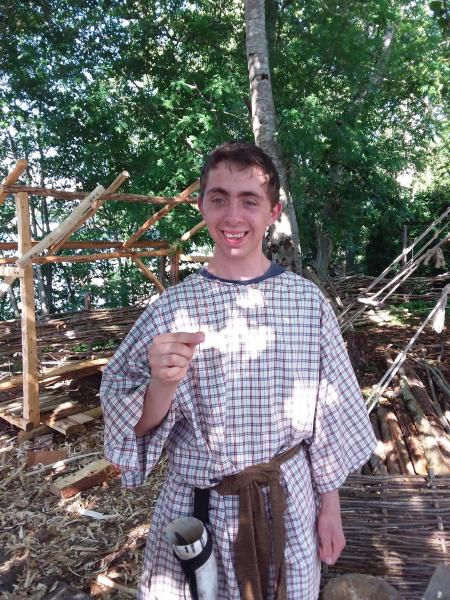Will Kent visited us with his parents in April this year. He was so inspired by what he discovered that he asked if he could possibly come to us for work experience.
Will has a condition affecting his eyesight which has been deteriorating since he was 6. He faces the prospect of losing his vision completely but Will is an inspiration to us all because he lets nothing get in his way. These are his own words of his experience at the Centre!
During the last week of June, I helped at the Crannog Centre. It is a place like no other, lying upon Loch Tay’s shore, hidden behind a veil of oak and pine trees. But what at first seems small and insignificant soon shows a vast wealth of knowledge. Stepping through this barrier is like taking a step backwards in time. The ghosts of our Iron-age forefathers can almost be heard in the waters that lap upon the beach. Their voices need not speak for instead they can show us what they did in the evidence they left behind at the real crannog. Through their failures and waste, we find a window through which we have learnt their ways using experimental archaeology. What has been learnt about this time is there for all to see in this living museum. The crannog itself sits upon the water and when entered one soon forgets that the modern world still lies beyond its walls. Back on the land, tools and other equipment are shown; for cooking, building and making clothes and dyes. All who work there dress the part wearing clothes like those of the period.
As part of my experience, I was fortunate enough to be able to go in one of the reconstructed log boats out onto the loch. It is made from a tree, carved out with iron age tools and is a reconstruction of the Carpow log boat that can be seen at the Perth museum. They are quick and surprisingly stable as they glide through the crystal waters. The boat’s prow is not pointed and so causes a lot of resistance to the water. This makes it harder to move the boat and adds to the challenge. In the past, these were used for transporting goods for selling and those which were bought.
I was also taught how to make wooden hurdles by Dirk. These fences, small or large, were used for many things like making pens for animals or just simple separators outdoors or in. It is not a complicated procedure, but it was not long before my hands were complaining at the exercise. Unlike modern fences these were completely sustainable and recyclable. I got to try food cooked in an Iron-Age way, used Iron-Age lathes to sculpt wood, made fire and learnt many of the skills that the staff are interested in, such as weapons by Rachel and dyes by Jason. I also accompanied tours with all the staff learning lots about Iron-Age life.
At the end of my week’s service, I was kindly gifted a brass swan neck broach made by Richard which will be worn with my school uniform. My week at the crannog was an unforgettable one and I have many great memories that will stick with me for years to come. Being blind sometimes makes me feel I cannot do things, but the staff at the Crannog Centre have ensured that the experience was accessible and enjoyable, and I highly recommend all to visit the place. I guarantee you will learn a great amount about this period, as those people who work there are always full of energy and happy to share their knowledge. Just ask them questions and you will find out!
Thank you to all the staff at the Crannog Centre for helping me during the week and to Gayle for organising it. I am already looking forward to coming back to the ‘Celts are Coming’ event!
Rich, Will and Dirk just before they launched the logboat.




